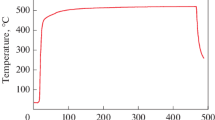Conclusions
The investigation of the initiation and growth kinetics of pores, dislocation structure, and particles of phase inclusions at fluxes of 1–100 dislocation/atom leads to the following conclusions.
-
1.
The dependence of the pore concentration in steels on the flux is described by a power law; the power-law index depends strongly on the composition of the steel and the irradiation temperature. The mean pore diameter in the initial period of irradiation varies according to the law (Kt)1/2; at large fluxes, it remains almost constant.
-
2.
In all the steels investigated, at fluxes above 5 dislocation/atom, the total dislocation density increases according to a power law; the power-law index varies from 0.4 to 1 depending on the composition of the steel and the irradiation temperature.
-
3.
In the initial period of irradiation, a stage of accelerated inclusion-particle initiation is observed, while at high fluxes they are seen to coalesce. The correlation of the kinetics of inclusion-particle initiation and growth with the dislocation density and the irradiation temperature has been established.
-
4.
The effect of the chemical composition of the steel, which is particularly clearly expressed at low temperature and small fluxes, is evidently due to the action of the alloying elements either on the ability of the dislocations to capture interstitial atoms or on the mechanism of the formation of new-phase inclusions.
Similar content being viewed by others
Literature Cited
V. I. Shcherbak et al., in: Problems of Atomic Science and Engineering. Fuel and constructional Materials Series [in Russian], No. 1 (6), Izd. VNIINM, Moscow (1977), p. 14.
V. I. Shcherbak et al., in: Problems of Atomic Science and Engineering. Radiation-Damage Physics and Radiational Materials Science Series [in Russian], No. 1(4), Kharkov Physicotechnical Institute (1977), p. 83.
V. I. Shcherbak et al., in: Proceedings of an International Conference on Radiational Effects in Breeder Reactor Structural Materials, Met. Soc. AIME (1978), p. 773.
A. N. Vorob'ev et al., J. Nucl. Energ. Soc.,14, No. 2, 149 (1977).
S. I. Porollo et al., At. Energ.,43, No. 3, 207 (1977).
V. I. Shcherbak, V. N. Bykov, and V. D. Dmitriev, Fiz. Met. Metalloved.,43, No. 2, 419 (1977).
V. I. Shcherbak et al., J. Brit. Nucl. Energ. Soc.,14, No. 2, 145 (1975).
I. M. Lifshchits and V. V. Slezov, Zh. Eksp. Teor. Fiz.,35, 47 (1958).
A. Ardell, Acta Met.,20, 61 (1972).
F. Smidt and J. Sprague, Scripta Met.,7, No. 5, 495 (1973).
H. Venker and K. Ehrlich, J. Nucl. Mater.,60, 347 (1976).
R. Bullough and R. Perrin, in: Proceedings of a European Conference on Voids Formed by Irradiation of Reactor Materials, BNES, Reading (1971), p. 78.
Additional information
This is an adaptation of a paper read to the Conference on Reactor Materials Science, Alushta, 1978.
Translated from Atomnaya Énergiya, Vol. 46, No. 2, pp. 91–96, February, 1979.
Rights and permissions
About this article
Cite this article
Shcherbak, V.I., Bykov, V.N., Dmitriev, V.D. et al. Effect of irradiation conditions and chemical composition on radiational-damage development in steels and alloys irradiated by neutrons. At Energy 46, 101–106 (1979). https://doi.org/10.1007/BF01207607
Issue Date:
DOI: https://doi.org/10.1007/BF01207607




